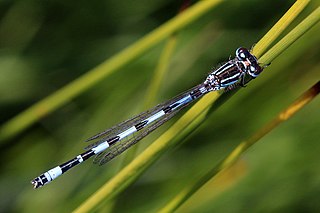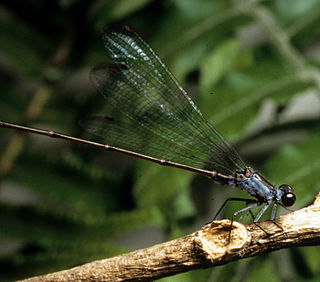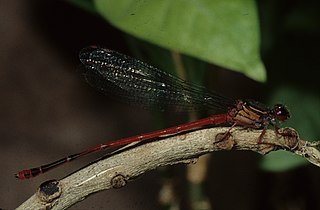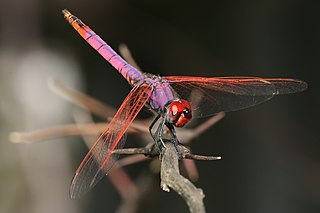
The Large red damselfly, Pyrrhosoma nymphula, is a species of damselflies belonging to the family Coenagrionidae.

Megalagrion is a genus of damselflies in the family Coenagrionidae It contains approximately 26 species, all of which are endemic to Hawaiʻi.
Ceriagrion georgifreyi is a species of damselfly in the family Coenagrionidae. It is found in Greece, Syria, Turkey, and possibly Lebanon. Its natural habitats are rivers and freshwater springs. It is threatened by habitat loss.
Chlorolestes elegans is a species of damselfly in the family Synlestidae. It is found in Botswana, Malawi, Mozambique, South Africa, and Zimbabwe. Its natural habitats are subtropical or tropical moist montane forests and rivers. It is threatened by habitat loss.

Coenagrion mercuriale, the southern damselfly, is a species of damselfly in the family Coenagrionidae. It is found in Algeria, Austria, Belgium, France, Germany, Italy, Liechtenstein, Luxembourg, Morocco, the Netherlands, Portugal, Romania, Slovakia, Slovenia, Spain, Switzerland, Tunisia, and the United Kingdom. Its natural habitats are rivers and freshwater springs. It is threatened by habitat loss.

Megalagrion leptodemas is a species of damselfly in the family Coenagrionidae that is endemic to the island of Oʻahu in Hawaii. It inhabits rivers in the Waiʻanae and Koʻolau ranges. It is threatened by habitat loss. It is currently labeled as critically endangered.

Megalagrion nesiotes is a species of damselfly in the family Coenagrionidae. Its common name is flying earwig Hawaiian damselfly. It is endemic to Hawaiʻi, where it is known from only one location on the island of Maui. It is extirpated from the island of Hawaii. This insect was federally listed as an endangered species of the United States in 2010.

Megalagrion oceanicum is a species of damselfly in the family Coenagrionidae that is endemic to the island of Oʻahu in Hawaii. It inhabits rivers in the Waiʻanae and Koʻolau ranges. It is threatened by habitat loss.

Megalagrion pacificum is a species of damselfly in the family Coenagrionidae. It is endemic to rivers and freshwater marshes in Hawaiʻi, especially the island of Molokaʻi. It is threatened by habitat loss. This insect was federally listed as an endangered species of the United States in 2010.

Nehalennia speciosa is a species of damselfly in the family Coenagrionidae. It is found in Austria, Belarus, Belgium, the Czech Republic, Denmark, Estonia, Finland, Germany, Italy, Japan, North Korea, Latvia, Lithuania, Luxembourg, the Netherlands, Poland, Romania, Russia, Slovakia, Sweden, Switzerland, Ukraine, possibly France, and possibly Kazakhstan. Its natural habitats are swamps, freshwater marshes, and open excavations. It is threatened by habitat loss.
Protoneura dunklei is a species of damselfly in the family Protoneuridae. It is found in the Dominican Republic and possibly Haiti. Its natural habitats are subtropical or tropical moist lowland forests and rivers. It is threatened by habitat loss.
Rhinocypha hageni is a species of damselfly in the family Chlorocyphidae. It is endemic to the Philippines. Its natural habitat is rivers. It is threatened by habitat loss.
Rhinocypha latimacula is a species of damselfly in the family Chlorocyphidae. It is endemic to the Philippines. Its natural habitat is rivers. It is threatened by habitat loss.
Sciotropis lattkei is a species of damselfly in the family Megapodagrionidae. It is endemic to Venezuela. Its natural habitats are subtropical or tropical moist lowland forests and rivers. It is threatened by habitat loss.

Trithemis is a genus of dragonflies in the family Libellulidae. They are commonly known as dropwings. There are over 40 species, mainly from Africa; two are endemic to Madagascar, and five can be found in Asia. They are found in a wide variety of habitats; some species being adapted to permanent streams in forests, and others being capable of breeding in temporary pools in deserts.

Zygonyx is a genus of dragonflies in the family Libellulidae. They are commonly known as cascaders because of their preference for living beside waterfalls and flying through the spray. They lay their eggs into the wet dangling roots of plants.
Codringtonia elisabethae is a species of air-breathing land snail, a terrestrial pulmonate gastropod mollusc in the family Helicidae, the typical snails.
Allocnemis abbotti, formerly Chlorocnemis abbotti, is a species of white-legged damselfly in the family Platycnemididae. It is found in Kenya, Malawi, and Tanzania. Its natural habitats are subtropical or tropical moist lowland forests, rivers, intermittent rivers, and freshwater springs. It is threatened by habitat loss.










